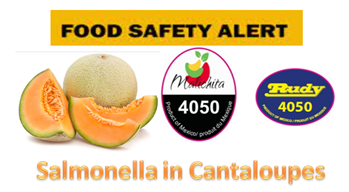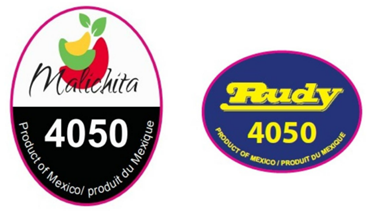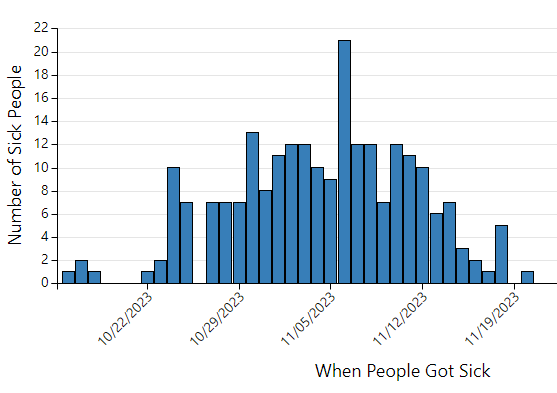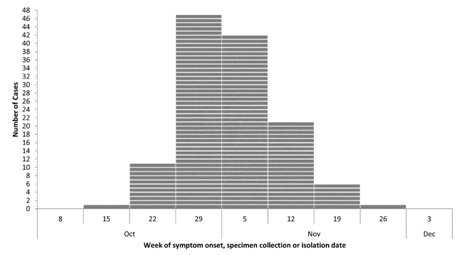The outbreak of Salmonella in cantaloupes October-November 2023
The current outbreak

The 2023 outbreak of Salmonella in cantaloupes hit the US and Canada in late October 2023. It caused 5 deaths in the US (two from Minnesota and one from Oregon) and 6 deaths in Canada. As of December 15, 2023, there are at least 302 people sick in the US in 42 states and 129 patients hospitalized, according to the CDC.
In Canada, as of December 15, 2023, were 153 cases confirmed, with 53 patients hospitalized (35%). There were illnesses in six provinces (British Columbia, Alberta, Ontario, Quebec, Prince Edward Island, New Brunswick, Newfoundland, and Labrador).
The strains of Salmonella involved are very virulent since at least 129 patients were hospitalized in the US (43%). Many cases involved children and the elderly.

The investigation identified Malichita and Rudy brand cantaloupes as the outbreak’s source. The outbreak was first posted on November 17, 2023. The cantaloupes in this outbreak are a product of Mexico. The Mexican government temporarily closed the cantaloupe processing facility on December 15, 2023, while investigating the source of Salmonella.
A ripple effect followed due to numerous vendors producing precut products from the recalled cantaloupes. The precut products were sold by ALDI, Vinyard, Freshness Guaranteed (sold by Walmart), KwiK Trip, Bix Produce, GHGA, Cut Fruit Express, Stop and Shop, and TGD.
Salmonella strains associated with the outbreak
The CDC reported that the rare strain of Salmonella isolated from the whole cantaloupes was Salmonella Sundsvall. There have been laboratory-confirmed cases of Salmonella Sundsvall in Canada, but there are also Salmonella Soahanina and Oranienburg. Whole Genome Sequencing (WGS) analysis shows that isolates from ill people in Canada and the US are genetically related. The outbreak strains of Salmonella are especially virulent since Salmonella infections usually don’t require hospitalization.
Illnesses timeline
The CDC reported that the first case of illnesses associated with the outbreak was on October 17, 2023. The CDC thart showed when the 302 people in the Salmonella outbreak got sick. It is essential to mention that the actual number of people who got sick in this outbreak is likely much higher because many recover without medical attention.
In Canada,

the information for the 129 case
s is shown below, the first case was observed
on October 15.
Why Are Cantaloupes Prone to Salmonella Contamination?
Cantaloupes and other melons grow close to the ground, resulting in contact with pathogens from soil, irrigation water, wild and domestic animals, and farm workers. Additionally, cantaloupes are not acidic and can support the growth of Salmonella once they are sliced open. Outbreaks of illness linked to melons contaminated with Salmonella are unfortunate each year.
Outbreaks due to cantaloupe over the years

Some examples of recent cantaloupes over the recent past include:
In August 2022, a multistate outbreak of S. Typhimurium was reported, with 87 illnesses and no deaths.
In October 2020, a multistate outbreak of Salmonella Newport related to watermelon and cantaloupe consumption. The outbreak included 15 states, with 80 cases of sick people, 17 hospitalized, and no deaths.
In November and December 2019, an outbreak of Salmonella Javiana was linked to cut fruits. One hundred sixty-five cases of illnesses were involved in 14 states, with 73 hospitalizations and no deaths.
In May 2019, an infection of Salmonella Carrau was reported in 10 states, with 137 people infected and 38 hospitalized.
In July 2018, an outbreak of Salmonella Adelaide in cut melons impacted 9 states, with 77 people reported ill, 36 hospitalized, and no death.
On June 8, 2018, a multistate outbreak of Salmonella Adelaide was reported due to the consumption of fresh cut melons in 9 states. 77 people were infected, with 36 people hospitalized.
In December 2017, an outbreak of Salmonella Newport in the states of Washington and Oregon due to the consumption of precut watermelon, cantaloupe, or fruit mixes containing watermelon or cantaloupe. 24 cases (Washington (21) and Oregon (3)), with 6 hospitalizations and one death, but it was not attributable to their salmonellosis.
Treatments to reduce Salmonella in cantaloupes
Salmonella survived and sometimes grew on cantaloupe rind for up to 14 days. After cutting the fruit, pathogens can survive and grow without refrigeration. Therefore, almost yearly outbreaks of Salmonella have occurred. Cutting the fruit can cause the transfer of pathogens. Most multistate outbreaks occur during production.
Various treatments were tested to remove pathogens, such as Salmonella, from the surfaces of cantaloupes. Soaking the cantaloupes in water or hydrocooled water was found to help somewhat in the Salmonella penetration into the rind.
Due to rapid biofilm formation on the cantaloupe rinds, the product is resistant to many antimicrobial treatments. Many treatments tested, such as steam, hot water, vinegar (5%), iodine (10%), hydrogen peroxide (3%), bleach, chlorine, lactic acid, and many others, were tested with limited success.
A combination of Nisin and EDTA solution was tested and found to be better than chlorinated water. Another chemical tested was 1% Delmopinol hydrochloride (delmopinol), an oral antiseptic mouthwash. The application of Delmophinol reduced Salmonella concentration by ~3.1 log CFU/ml.
Final word
With so many outbreaks of Salmonella in cantaloupes over the years and significant research efforts, one should have anticipated that research would develop a solution to the problem. While significant research was dedicated to eliminating or reducing Salmonella in cantaloupe, a real solution is not yet in sight. In recent years, outbreaks of Salmonella in melons have happened almost yearly. Older adults and young children are especially susceptible to such outbreaks.
Retailers like Aldi, Kwik Trip, Kroger, Stop and Shop, and Trader Joe’s have recalled precut cantaloupes. As a result of the outbreak, the CDC recommends not eating cut fruit mixes that contain cantaloupes from unknown sources.
The number of patients resulting from this outbreak is probably much higher than reported because it takes 3 to 4 weeks to classify people and establish that sick people are part of the outbreak. Not all sick people get medical attention.
New means to reduce the contamination of cantaloupes with Salmonella need to be developed
